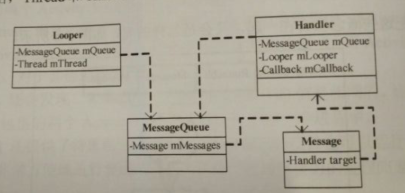жӮЁеҘҪпјҢзҷ»еҪ•еҗҺжүҚиғҪдёӢи®ўеҚ•е“ҰпјҒ
AndroidеҰӮдҪ•е®һзҺ°ејӮжӯҘж¶ҲжҒҜеӨ„зҗҶжңәеҲ¶е®һпјҹй’ҲеҜ№иҝҷдёӘй—®йўҳпјҢиҝҷзҜҮж–Үз« иҜҰз»Ҷд»Ӣз»ҚдәҶзӣёеҜ№еә”зҡ„еҲҶжһҗе’Ңи§Јзӯ”пјҢеёҢжңӣеҸҜд»Ҙеё®еҠ©жӣҙеӨҡжғіи§ЈеҶіиҝҷдёӘй—®йўҳзҡ„е°ҸдјҷдјҙжүҫеҲ°жӣҙз®ҖеҚ•жҳ“иЎҢзҡ„ж–№жі•гҖӮ
ж¶ҲжҒҜеӨ„зҗҶжңәеҲ¶дё»иҰҒеҜ№иұЎ:Looper,Handler,Message(иҝҳжңүMessageQueueе’ҢRunnable)
LooperдёҚж–ӯд»ҺMessageQueueж¶ҲжҒҜйҳҹеҲ—дёӯеҸ–еҮәдёҖдёӘMessageпјҢ然еҗҺдј з»ҷHandleпјҢеҰӮжӯӨеҫӘзҺҜеҫҖеӨҚпјҢеҰӮжһңйҳҹеҲ—дёәз©әпјҢйӮЈд№Ҳе®ғдјҡиҝӣе…Ҙдј‘зң гҖӮ
иҝҷдәӣзұ»зҡ„дё»иҰҒеҸҳйҮҸ
Looper.java
static final ThreadLocal<Looper> sThreadLocal = new ThreadLocal<Looper>(); private static Looper sMainLooper; // guarded by Looper.class final MessageQueue mQueue; final Thread mThread;
Handler.java
final MessageQueue mQueue; final Looper mLooper; final Callback mCallback; final boolean mAsynchronous; IMessenger mMessenger;
Message.java
Handler target;жҜҸдёӘж¶ҲжҒҜеҸӘиғҪеҜ№еә”дёҖдёӘhandler
Runnable callback;еӣһи°ғжҺҘеҸЈ
MessageQueue.java
Message mMessages;
RunnableжҳҜдёҖдёӘз©әжҺҘеҸЈзұ»пјҢжІЎжңүеҸҳйҮҸ
дёҠдёҖдёӘд№ҰдёҠзҡ„еӣҫпјҡ

Handlerе’ҢThreadжІЎжңүзӣҙжҺҘе…ізі»пјҢдҪҶеҜ№еә”е…ізі»еҸҜд»ҘжҺЁзҗҶеҫ—еҲ°
жҜҸдёӘThreadеҸӘеҜ№еә”дёҖдёӘLooperпјӣ
жҜҸдёӘLooperеҸӘеҜ№еә”дёҖдёӘMessageQueue;
жҜҸдёӘMessageQueueеҜ№еә”NдёӘMessageпјҢжҜҸдёӘMessageеҸӘеҜ№еә”дёҖдёӘHandler
==гҖӢжҜҸдёӘThreadеҜ№еә”NдёӘHandlerгҖӮ
HandlerжҳҜвҖқзңҹжӯЈеӨ„зҗҶдәӢжғ…вҖңзҡ„ең°ж–№пјҢдҪңз”ЁпјҡеӨ„зҗҶж¶ҲжҒҜпјҢе°ҶMessageеҺӢе…ҘMessageQueueдёӯ
еёҰзқҖдёҖдёӘй—®йўҳзңӢжәҗз ҒпјҡеҲӣе»әhandlerеҜ№иұЎзҡ„зәҝзЁӢпјҲui/дё»зәҝзЁӢйҷӨеӨ–пјүдёәд»Җд№ҲпјҢеҝ…йЎ»е…Ҳи°ғз”ЁLooper.prepare() пјҹ
public Handler() {
this(null, false);
}
public Handler(Callback callback) {
this(callback, false);
}
public Handler(Looper looper) {
this(looper, null, false);
}
public Handler(Looper looper, Callback callback) {
this(looper, callback, false);
}
public Handler(boolean async) {
this(null, async);
}
public Handler(Callback callback, boolean async) {
if (FIND_POTENTIAL_LEAKS) {
final Class<? extends Handler> klass = getClass();
if ((klass.isAnonymousClass() || klass.isMemberClass() || klass.isLocalClass()) &&
(klass.getModifiers() & Modifier.STATIC) == 0) {
Log.w(TAG, "The following Handler class should be static or leaks might occur: " +
klass.getCanonicalName());
}
}
mLooper = Looper.myLooper();
if (mLooper == null) {
throw new RuntimeException(
"Can't create handler inside thread that has not called Looper.prepare()");
}
mQueue = mLooper.mQueue;
mCallback = callback;
mAsynchronous = async;
}
public Handler(Looper looper, Callback callback, boolean async) {
mLooper = looper;
mQueue = looper.mQueue;
mCallback = callback;
mAsynchronous = async;
}еҲқе§ӢеҢ–handlerеҜ№иұЎж—¶(жһ„йҖ ж–№жі•жҳҜHandler(),Handler(Callback callback))йғҪй—ҙжҺҘи°ғз”ЁHandler(Callback callback, boolean async)жһ„йҖ ж–№жі•
дё»иҰҒд»Јз ҒжҳҜLooper.myLooper();
static final ThreadLocal<Looper> sThreadLocal = new ThreadLocal<Looper>();//иҝҷжҳҜеңЁLooperзұ»дёӯзҡ„е®ҡд№ү
public static Looper myLooper() {
return sThreadLocal.get();//д»ҺеҪ“еүҚзәҝзЁӢдёӯиҺ·еҫ—looperеҜ№иұЎ
}
public static void prepare() {
prepare(true);
}
private static void prepare(boolean quitAllowed) {
if (sThreadLocal.get() != null) {
throw new RuntimeException("Only one Looper may be created per thread");
}
sThreadLocal.set(new Looper(quitAllowed));//дёәеҪ“еүҚзәҝзЁӢи®ҫзҪ®looperеҜ№иұЎ
}жҲ‘们иҮӘе·ұеҲӣе»әзәҝзЁӢеҝ…йЎ»йҖҡиҝҮLooper.prepare()ж–№жі•дёәеҪ“еүҚзәҝзЁӢи®ҫзҪ®looperеҜ№иұЎжүҚеҸҜд»ҘйҖҡиҝҮLooper.myLooper()ж–№жі•иҝ”еӣһlooperеҜ№иұЎпјҢиҝҷж ·еңЁйқһUIзәҝзЁӢеҲӣе»әhandlerеҜ№иұЎж—¶жүҚдёҚдјҡжҠҘй”ҷгҖӮ"Can't create handler inside thread that has not called Looper.prepare()"
ps:prepare(boolean quitAllowed)(иҝҷдёӘдёҚз”ЁжҲ‘们关еҝғпјҢз•ҘиҝҮгҖӮгҖӮ)
иҝҷдёӘquitAlowedеҸӮж•°жҳҜе®ҡд№үж¶ҲжҒҜйҳҹеҲ—з”ЁдәҶпјҢзңӢзҡ„жәҗд»Јз ҒжҳҜandroid4.4
Looper.javaprivate Looper(boolean quitAllowed) {
mQueue = new MessageQueue(quitAllowed);
mRun = true;
mThread = Thread.currentThread();
}MessageQueue.java
// True if the message queue can be quit. private final boolean mQuitAllowed;//trueж¶ҲжҒҜйҳҹеҲ—еҸҜд»Ҙиў«quitпјҢfalseж¶ҲжҒҜйҳҹеҲ—дёҚиғҪиў«quitгҖӮдё»зәҝзЁӢ/UIзәҝзЁӢзҡ„MessageQueueдёҚиғҪиў«й”ҖжҜҒжҺүгҖӮзңӢжәҗз ҒпјҲй”ҖжҜҒи°ғз”ЁLooper.quit()пјү
public static void prepareMainLooper() {
prepare(false);
synchronized (Looper.class) {
if (sMainLooper != null) {
throw new IllegalStateException("The main Looper has already been prepared.");
}
sMainLooper = myLooper();
}
}еҒҸзҰ»еӨӘиҝңдәҶ
жүҖд»Ҙеҫ—еҮәз»“и®әпјҡеҲӣе»әhandlerеҜ№иұЎзҡ„зәҝзЁӢпјҲui/дё»зәҝзЁӢйҷӨеӨ–пјүпјҢеҝ…йЎ»е…Ҳи°ғз”ЁLooper.prepare()
HandlerдҪңз”Ё1пјҡеӨ„зҗҶж¶ҲжҒҜ
еңЁLooperзұ»дёӯеӨ„зҗҶж¶ҲжҒҜжҳҜйҖҡиҝҮmsg.target.dispatchMessage(msg);targetе°ұжҳҜhandlerеҜ№иұЎпјҲMessageзұ»зҡ„еҶ…йғЁеҸҳйҮҸHandler targetпјүе°Ҷж¶ҲжҒҜиҪ¬еҸ‘еҲ°еӨ„зҗҶж¶ҲжҒҜзҡ„еҜ№еә”зҡ„handlerеҜ№иұЎдёҠ,然еҗҺиҝҷдёӘtargetеҚіhandlerеҜ№иұЎдјҡеңЁеӨ„зҗҶж¶ҲжҒҜеүҚеҒҡдёҖдёӘжЈҖжҹҘ
public void dispatchMessage(Message msg) {
if (msg.callback != null) {//еҰӮжһңmsgжңүз»‘е®ҡcallbackеӣһи°ғжҺҘеҸЈRunaableдёҚдёәз©әпјҢеҲҷжү§иЎҢRunnableзҡ„runж–№жі•
handleCallback(msg);
} else {
if (mCallback != null) {//еҰӮжһңhandlerзҡ„еҶ…зҪ®жҺҘеҸЈзұ»CallbackдёҚдёәз©әпјҢеҲҷжү§иЎҢboolean handleMessage(Message msg)иҝҷдёӘж–№жі•
if (mCallback.handleMessage(msg)) {жү§иЎҢе®ҢжҲҗеҲҷreturn
return;
}
}
handleMessage(msg);//жңҖеҗҺжүҚжү§иЎҢhandlerжң¬иә«зҡ„ж–№жі•
}
}
private static void handleCallback(Message message) { message.callback.run(); }
public interface Callback {//handlerзҡ„еҶ…зҪ®жҺҘеҸЈзұ»Callback
public boolean handleMessage(Message msg);
}HandlerдҪңз”Ё2пјҡе°ҶMessageеҺӢе…ҘMessageQueueдёӯ
handlerдёӯжҸҗдҫӣзҡ„еҫҲеӨҡеҸ‘йҖҒmessageзҡ„ж–№жі•пјҢйҷӨдәҶsendMessageAtFrontOfQueue()ж–№жі•пјҲзӣҙжҺҘи°ғз”ЁenqueueMessage(queue, msg, 0);пјүд№ӢеӨ–пјҢе…¶е®ғзҡ„еҸ‘йҖҒж¶ҲжҒҜж–№жі•жңҖз»ҲйғҪдјҡиҫ—иҪ¬и°ғз”ЁеҲ°sendMessageAtTime()ж–№жі•
public boolean sendMessageAtTime(Message msg, long uptimeMillis) {
MessageQueue queue = mQueue;
if (queue == null) {
RuntimeException e = new RuntimeException(
this + " sendMessageAtTime() called with no mQueue");
Log.w("Looper", e.getMessage(), e);
return false;
}
return enqueueMessage(queue, msg, uptimeMillis);
}sendMessageAtTime()ж–№жі•д№ҹжҳҜи°ғз”ЁHandlerдёӯзҡ„enqueueMessage(queue, msg, uptimeMillis)ж–№жі•
е’ҢsendMessageAtFrontOfQueue()ж–№жі•дёӨиҖ…жңҖеҗҺйғҪдјҡи°ғз”ЁenqueueMessage(queue, msg, uptimeMillis)ж–№жі•
еҢәеҲ«жҳҜйңҖиҰҒ延иҝҹuptimeMillisж—¶й—ҙеҗҺжүҚе°ҶMessageеҺӢе…ҘMessageQueueдёӯ
private boolean enqueueMessage(MessageQueue queue, Message msg, long uptimeMillis) {
msg.target = this;//з»ҷmsgзҡ„targetиөӢеҖјдёәhandlerиҮӘиә«з„¶еҗҺеҠ е…ҘMessageQueueдёӯ
if (mAsynchronous) {
msg.setAsynchronous(true);
}
return queue.enqueueMessage(msg, uptimeMillis);
}жңҖз»ҲжүҖжңүзҡ„ж–№жі•йғҪжҳҜи°ғз”ЁMessageQueueдёӯзҡ„enqueueMessage(msg, uptimeMillis);ж–№жі•пјҢжҳҜдёҚжҳҜж„ҹи§үдёӨдёӘж–№жі•е·®дёҚеӨҡе•ҠпјҢжіЁж„ҸеҸӮж•°пјҒпјҒ
MessageQueueзҡ„дҪҝз”ЁжҳҜеңЁLooperдёӯ
Handlerзҡ„дҪңз”Ёж•ҙзҗҶе®ҢжҜ•пјҲеҘҪеғҸжҲ‘зҺ°еңЁе·Із»ҸеҸҜд»ҘжҠҠHandlerжәҗз Ғе®Ңж•ҙй»ҳеҶҷдёӢжқҘдәҶгҖӮе“Ҳе“Ҳ^.^и®°еҝҶеҠӣзңҹдёҚиЎҢпјү
Looperзұ»
дҪңз”ЁпјҡдёҺеҪ“еүҚзәҝзЁӢз»‘е®ҡпјҢдҝқиҜҒдёҖдёӘзәҝзЁӢеҸӘдјҡжңүдёҖдёӘLooperе®һдҫӢпјҢеҗҢж—¶дёҖдёӘLooperе®һдҫӢд№ҹеҸӘжңүдёҖдёӘMessageQueueгҖӮ
еҜ№дәҺLooperдё»иҰҒжҳҜprepare()е’Ңloop()дёӨдёӘж–№жі•
prepare()е°Ҷжҷ®йҖҡзәҝзЁӢиҪ¬еҢ–дёәlooperзәҝзЁӢпјҢ
loop()ж–№жі•пјҢдёҚж–ӯд»ҺMessageQueueдёӯеҺ»еҸ–ж¶ҲжҒҜпјҢдәӨз»ҷж¶ҲжҒҜзҡ„targetеұһжҖ§зҡ„dispatchMessageеҺ»еӨ„зҗҶгҖӮ
public static void loop() {
final Looper me = myLooper();
if (me == null) {
throw new RuntimeException("No Looper; Looper.prepare() wasn't called on this thread.");
}
final MessageQueue queue = me.mQueue;
// Make sure the identity of this thread is that of the local process,
// and keep track of what that identity token actually is.
Binder.clearCallingIdentity();
final long ident = Binder.clearCallingIdentity();
for (;;) {
Message msg = queue.next(); // might block
if (msg == null) {
// No message indicates that the message queue is quitting.
return;
}
// This must be in a local variable, in case a UI event sets the logger
Printer logging = me.mLogging;
if (logging != null) {
logging.println(">>>>> Dispatching to " + msg.target + " " +
msg.callback + ": " + msg.what);
}
msg.target.dispatchMessage(msg);
if (logging != null) {
logging.println("<<<<< Finished to " + msg.target + " " + msg.callback);
}
// Make sure that during the course of dispatching the
// identity of the thread wasn't corrupted.
final long newIdent = Binder.clearCallingIdentity();
if (ident != newIdent) {
Log.wtf(TAG, "Thread identity changed from 0x"
+ Long.toHexString(ident) + " to 0x"
+ Long.toHexString(newIdent) + " while dispatching to "
+ msg.target.getClass().getName() + " "
+ msg.callback + " what=" + msg.what);
}
msg.recycle();
}
}27иЎҢе°ұжҳҜдёҠйқўжҸҗеҲ°дәҶпјҢhandlerиҝӣиЎҢж¶ҲжҒҜеӨ„зҗҶзҡ„е…ій”®д»Јз ҒдәҶ
зңӢзқҖдёҠйқўзҡ„еҲҶжһҗеҫҲеӨҚжқӮпјҢжҖ»з»“дёӢ
1гҖҒйҰ–е…ҲLooper.prepare()дёәеңЁеҪ“еүҚзәҝзЁӢдёӯдҝқеӯҳдёҖдёӘLooperе®һдҫӢпјҲsThreadLocal.set()пјүпјҢ然еҗҺиҜҘе®һдҫӢдёӯдҝқеӯҳдёҖдёӘMessageQueueеҜ№иұЎпјӣеӣ дёәLooper.prepare()еңЁдёҖдёӘзәҝзЁӢдёӯеҸӘиғҪи°ғз”ЁдёҖж¬ЎпјҢжүҖд»ҘMessageQueueеңЁдёҖдёӘзәҝзЁӢдёӯеҸӘдјҡеӯҳеңЁдёҖдёӘгҖӮ
2гҖҒLooper.loop()дјҡи®©еҪ“еүҚзәҝзЁӢиҝӣе…ҘдёҖдёӘж— йҷҗеҫӘзҺҜпјҢдёҚз«Ҝд»ҺMessageQueueзҡ„е®һдҫӢдёӯиҜ»еҸ–ж¶ҲжҒҜпјҢ然еҗҺеӣһи°ғmsg.target.dispatchMessage(msg)ж–№жі•гҖӮ
3гҖҒHandlerзҡ„жһ„йҖ ж–№жі•пјҢдјҡйҰ–е…Ҳеҫ—еҲ°еҪ“еүҚзәҝзЁӢдёӯдҝқеӯҳзҡ„Looperе®һдҫӢпјҢиҝӣиҖҢдёҺLooperе®һдҫӢдёӯзҡ„MessageQueueжғіе…іиҒ”гҖӮ
4гҖҒHandlerзҡ„sendMessageж–№жі•пјҢдјҡз»ҷmsgзҡ„targetиөӢеҖјдёәhandlerиҮӘиә«пјҢ然еҗҺеҠ е…ҘMessageQueueдёӯгҖӮ
5гҖҒеңЁжһ„йҖ Handlerе®һдҫӢж—¶пјҢжҲ‘们дјҡйҮҚеҶҷhandleMessageж–№жі•пјҢд№ҹе°ұжҳҜmsg.target.dispatchMessage(msg)жңҖз»Ҳи°ғз”Ёзҡ„ж–№жі•гҖӮ
е…ідәҺAndroidеҰӮдҪ•е®һзҺ°ејӮжӯҘж¶ҲжҒҜеӨ„зҗҶжңәеҲ¶е®һй—®йўҳзҡ„и§Јзӯ”е°ұеҲҶдә«еҲ°иҝҷйҮҢдәҶпјҢеёҢжңӣд»ҘдёҠеҶ…е®№еҸҜд»ҘеҜ№еӨ§е®¶жңүдёҖе®ҡзҡ„её®еҠ©пјҢеҰӮжһңдҪ иҝҳжңүеҫҲеӨҡз–‘жғ‘жІЎжңүи§ЈејҖпјҢеҸҜд»Ҙе…іжіЁдәҝйҖҹдә‘иЎҢдёҡиө„и®Ҝйў‘йҒ“дәҶи§ЈжӣҙеӨҡзӣёе…ізҹҘиҜҶгҖӮ
е…ҚиҙЈеЈ°жҳҺпјҡжң¬з«ҷеҸ‘еёғзҡ„еҶ…е®№пјҲеӣҫзүҮгҖҒи§Ҷйў‘е’Ңж–Үеӯ—пјүд»ҘеҺҹеҲӣгҖҒиҪ¬иҪҪе’ҢеҲҶдә«дёәдё»пјҢж–Үз« и§ӮзӮ№дёҚд»ЈиЎЁжң¬зҪ‘з«ҷз«ӢеңәпјҢеҰӮжһңж¶үеҸҠдҫөжқғиҜ·иҒ”зі»з«ҷй•ҝйӮ®з®ұпјҡis@yisu.comиҝӣиЎҢдёҫжҠҘпјҢ并жҸҗдҫӣзӣёе…іиҜҒжҚ®пјҢдёҖз»ҸжҹҘе®һпјҢе°Ҷз«ӢеҲ»еҲ йҷӨж¶үе«ҢдҫөжқғеҶ…е®№гҖӮ
жӮЁеҘҪпјҢзҷ»еҪ•еҗҺжүҚиғҪдёӢи®ўеҚ•е“ҰпјҒ